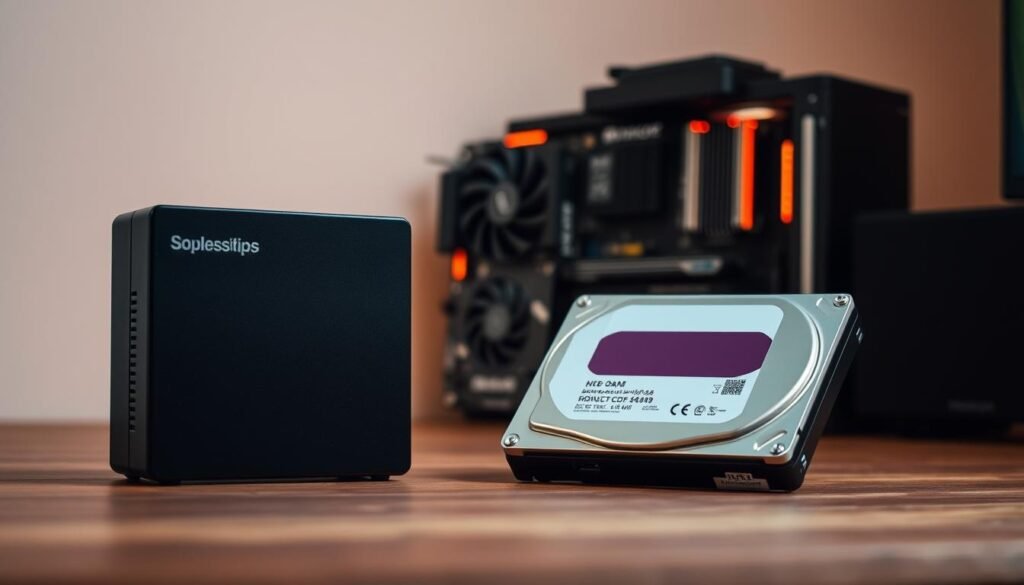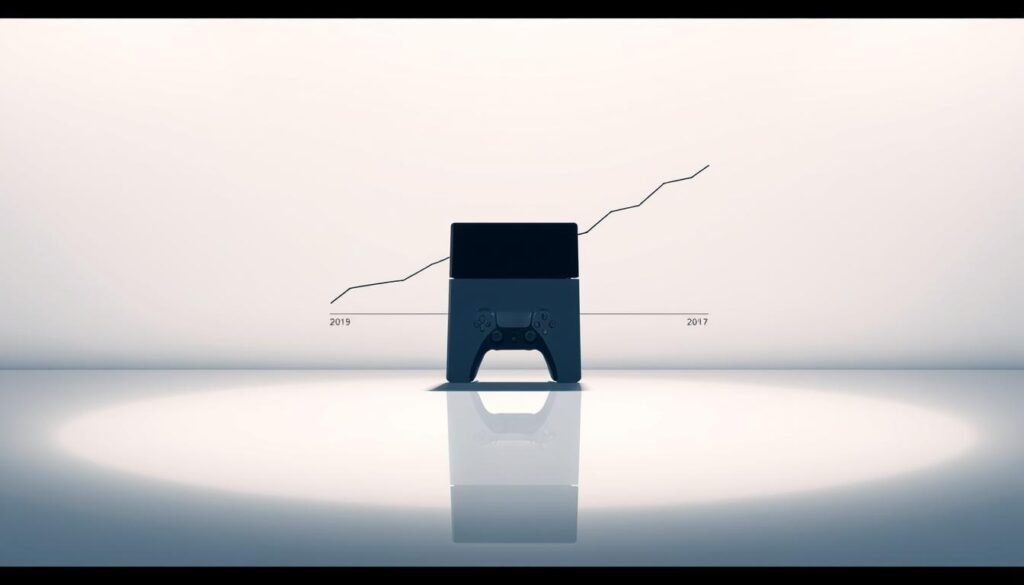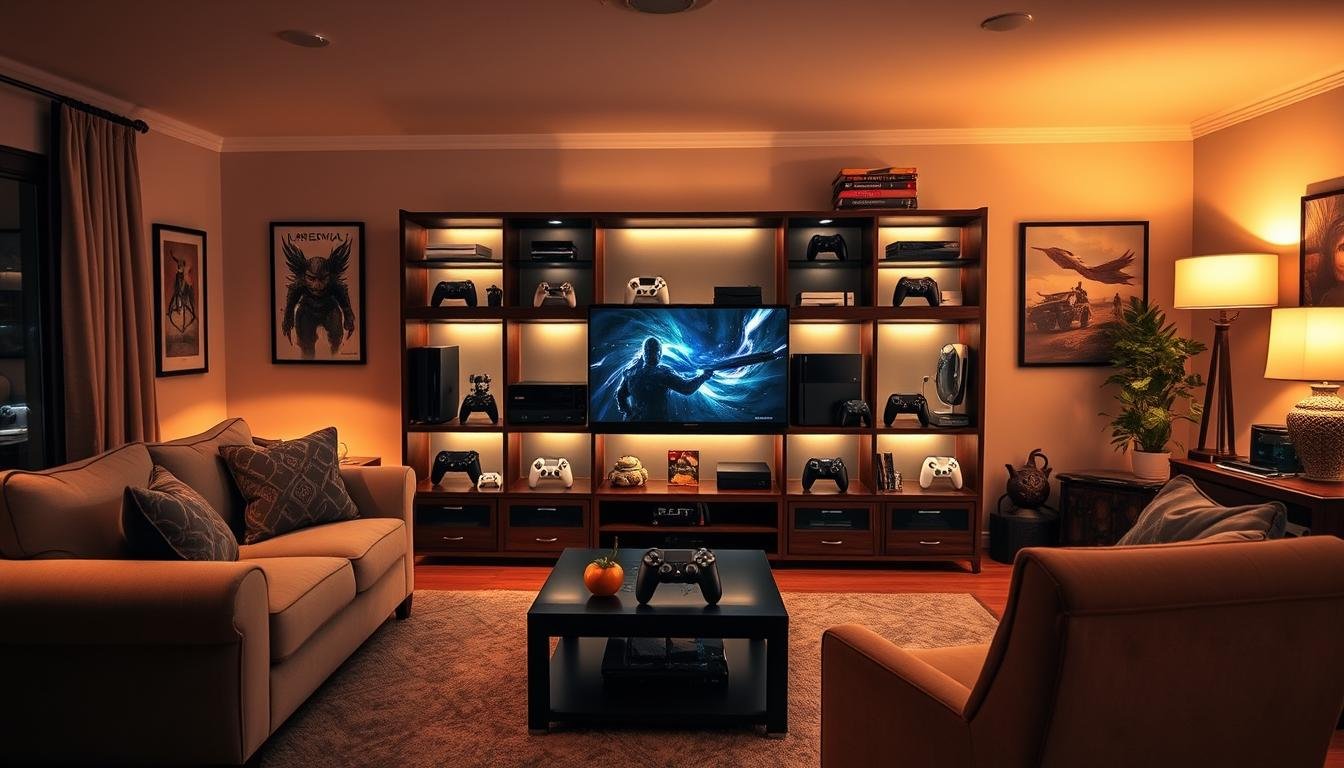I remember the night I turned off the lights and sank into the couch. The room glowed with a new screen. It wasn’t just a purchase—it was a promise. In a busy U.S. household, the right Gaming Console can be a weekend ritual, a stress break after work, or a way to laugh with family on a rainy Sunday.
That’s why I look past hype and match a video game system to real life. Do I want couch co-op in the living room, or late-night online squads with friends across the country? Am I craving cinematic single-player epics or short indie gems after dinner? If my game console also needs to handle Netflix, Hulu, and Spotify, I weigh that too, because home entertainment matters as much as frame rates.
Today’s lineup is strong: Sony PlayStation 5, Microsoft Xbox Series X|S, and Nintendo Switch or Switch OLED. I also watch the rise of handheld-and-TV hybrids that travel from backpack to dock without fuss. Each has a voice and a vibe, from buttery 4K showcases to playful portability that makes console gaming feel simple and social.
In this guide, I’ll break down what counts for my setup in the United States: next-gen performance and graphics (4K, HDR, 120 Hz), exclusive games and ecosystems, controller design and accessibility, online services and subscriptions, backward compatibility, storage and load times, family controls, noise and power use, and when it’s smart to buy. My goal is clear: choose a Gaming Console that fits how I live, play, and watch—without regret.
Key Takeaways
- Pick a video game system that matches how you play: couch co-op, online multiplayer, or solo adventures.
- Consider the big three—PlayStation 5, Xbox Series X|S, and Nintendo Switch/Switch OLED—plus hybrid handheld options.
- Think beyond games: a game console can double as a home entertainment hub with top streaming apps.
- Plan for specs that matter to you, like 4K, HDR, and high refresh rates for smoother console gaming.
- Look at ecosystems, controllers, and accessibility to ensure long-term comfort and value.
- Don’t forget storage, load times, and backward compatibility for a smoother library experience.
- Time your purchase around sales and bundles to get the best deal.
How I Choose a Video Game Console for My Lifestyle
I aim for a gaming setup that matches my lifestyle and living room. I see each console as a way to unwind, play with friends, and share the TV. I seek a console that’s fast, quiet, and reliable every time.
Balancing budget, performance, and exclusives
I compare prices and deals, including subscription costs. I look for U.S. promos that offer controllers or games for free. This helps me find the best value.
Performance is key. I check the console’s power, design, and speed. I also consider exclusive games. The best console offers great value and must-have games.
What matters most for my home setup
I need a console that supports 4K at 120 Hz. Quiet and compact designs are important, as my space is limited. Strong Wi-Fi ensures smooth online play.
Travel is another factor. A portable console like the Nintendo Switch is perfect for trips. For VR, I look for support on the PS5. These features help me choose the right console for my lifestyle.
Console gaming vs. PC gaming: why I pick one over the other
Console gaming is great for easy plug-and-play. It offers consistent performance and controller support. I choose based on where my friends and I usually play.
PC gaming is better for customization and high frame rates. However, it requires more effort and money. I prefer consoles for relaxation and PCs for tinkering. My choice depends on the night’s plans and my mood.
Gaming Console
A modern gaming console offers a simple start. It has standardized hardware and a unified interface. It also has a store that ties games, add-ons, and friends together.
I can use digital downloads or pop in a disc. The same dashboard handles streaming apps and social features. This makes it feel plug-and-play yet still like a full video game system.
What I get under the hood matters. PlayStation 5 and Xbox Series X|S use AMD RDNA 2 graphics and ultra-fast NVMe SSDs. This makes load times drop to seconds. VRR support on PS5 and Xbox smooths frame pacing on compatible TVs.
Controllers connect over Bluetooth or proprietary wireless. This keeps latency low on each game console.
The current lineup covers different needs. PlayStation 5 comes in a disc model and a Digital Edition, both focused on high-end performance. Xbox Series X targets 4K fidelity, while Xbox Series S aims for a compact, 1440p-friendly setup.
Nintendo Switch and Switch OLED work as a hybrid. They slide from the dock to handheld play. This changes how I use a gaming platform day to day.
Ecosystems shape the feel. DualSense on PS5 adds adaptive triggers and detailed haptics. Xbox supports Play Anywhere on select titles and offers broad backward compatibility. Nintendo leads with first-party hits and family-friendly design.
I pick digital or physical purchases based on storage and resale. Knowing each video game system handles libraries a bit differently helps.
Storage choices affect convenience. Fast internal SSDs speed up launches. But big games fill space quickly, so I plan for expansion cards on Xbox, M.2 NVMe drives on PS5, or microSD on Switch. This keeps my gaming console ready without constant uninstalling.
| Model | Core Focus | Graphics/Storage | Display & Features | Ecosystem Highlights | Media Format |
|---|---|---|---|---|---|
| PlayStation 5 (Disc / Digital Edition) | High performance console gaming | AMD RDNA 2 GPU, ultra-fast NVMe SSD | Up to 4K; VRR on compatible TVs; DualSense haptics | Exclusive titles from Sony studios; robust share tools | Disc on standard PS5; digital only on Digital Edition |
| Xbox Series X | 4K powerhouse gaming platform | AMD RDNA 2 GPU, ultra-fast NVMe SSD | Up to 4K; VRR; Quick Resume across multiple games | Play Anywhere (select titles), wide backward compatibility | 4K UHD Blu-ray plus digital |
| Xbox Series S | Compact, budget-friendly game console | AMD RDNA 2 GPU, ultra-fast NVMe SSD | Targets 1440p; VRR; Quick Resume | Same Xbox ecosystem and services in a smaller package | Digital only |
| Nintendo Switch / Switch OLED | Hybrid video game system (handheld and TV dock) | Custom NVIDIA Tegra; microSD expansion | 720p handheld, up to 1080p docked; portable play | Strong first-party library; family-focused experiences | Game cards and digital |
Understanding Next-Gen Performance and Graphics
I check my TV’s capabilities before setting up my gaming console. In console gaming, matching features with power is key. The PS5 and Xbox Series X offer top-notch performance, but the best results come from smart settings and a well-tuned display.
4K, HDR, and high refresh rates explained
Many games on PS5 and Xbox Series X are in true 4K. However, some use tricks to keep the game smooth. Xbox Series S and Nintendo Switch usually aim for 1080p or 1440p.
For HDR, I use HDR10 on both consoles and adjust for the best brightness and black levels. A good TV’s local dimming enhances contrast and color. Dolby Vision gaming is available on Xbox Series X|S with the right TV, while PS5 uses HDR10.
HDMI 2.1 allows for 120 Hz and VRR, making fast gaming smoother and reducing tearing.
Ray tracing and visual fidelity in modern games
Ray tracing adds realistic reflections, sharper shadows, and natural lighting. Most games use a mix of old and new techniques for quality and cost. On a good gaming platform, the visuals are stunning, especially in wet scenes and glass.
Ray tracing is demanding, so I watch how consoles handle it. VRR helps with smooth gaming, but I prefer stable frame rates for the best experience.
Performance modes vs. quality modes
Performance Mode aims for fast frame rates by reducing graphics. Quality Mode focuses on higher resolution and richer graphics, often at lower frame rates. I choose based on the game type: fast games need high fps, while detailed games benefit from higher resolution.
If a game supports 40 fps at 120 Hz, I use VRR on my TV. It’s a great balance between clarity and smoothness. I always check the input response to ensure every moment feels right on my console.
Exclusive Games and Ecosystem Lock-In
Choosing a game console is a big decision. PlayStation’s studios, like Naughty Dog and Insomniac Games, create epic games. These games make me want to play on PlayStation first, especially for new chapters in my favorite series.
Xbox offers great games like Starfield and Forza Motorsport on day one. With cloud play and cross‑progression, my gaming experience is flexible. Playing with friends on Xbox Live and cross‑play makes every night exciting.
Nintendo has its own charm. Games like Mario and Zelda give it a warm, social feel. Local co-op and family nights are special, thanks to Nintendo’s quality games.
When deciding, I consider cross-buy, cloud saves, and achievements. Exclusivity windows and prices can influence my choice. But, playing with friends is what really decides my weekend plans.
When an ecosystem rewards my time with portable saves, steady discounts, and a lively friends list, I stay longer and spend smarter.
| Ecosystem | Exclusive Strength | Service Hooks | Cross-Play/Progress | Why I Gravitate |
|---|---|---|---|---|
| PlayStation | Narrative blockbusters from Naughty Dog, Santa Monica Studio, Insomniac Games, Guerrilla Games | PS Plus tiers, trophy system, frequent timed exclusives | Selective cross-play; cloud saves with subscription | Prestige single‑player on a video game console with slick DualSense features |
| Xbox | Day‑one releases from Xbox Game Studios and Bethesda (e.g., Starfield, Forza titles) | Game Pass, cloud gaming, Smart Delivery, robust achievements | Strong cross‑play; broad cross‑progression with PC | Flexible gaming platform that follows me across devices and sessions |
| Nintendo | First‑party icons: Mario, The Legend of Zelda, Splatoon, Animal Crossing | Nintendo Switch Online, retro catalogs, family plans | Limited cross‑play; cloud saves for many titles | Distinctive video game system identity and family‑friendly local play |
| Third‑Party Factors | Timed exclusivity windows; console‑first releases | Regional pricing, bundles, loyalty discounts | Publisher accounts for cross‑progression | Can sway which game console I buy a title on and where I keep my library |
Controller Design, Haptics, and Accessibility
I look at a gaming console’s controller first. The PS5 DualSense feels great in my hands. The Xbox Wireless Controller has textured grips and an asymmetrical stick layout for better aim. Nintendo’s Joy‑Con and the Switch Pro Controller are perfect for playing on the sofa.
Ergonomics and input latency that affect gameplay
Comfort is key, but latency is what wins games. I prefer wired USB for the best performance. The DualSense and Xbox’s adapters are close seconds. I also adjust my TV settings to reduce lag.
Advanced haptics, adaptive triggers, and motion controls
The DualSense’s adaptive triggers and haptics are amazing. Astro’s Playroom shows off these features. Xbox has impulse triggers and a wide range of accessories. Nintendo’s HD Rumble and motion controls add a fun touch to games.
Accessibility features I look for in a gaming device
I want systems that offer customization. Things like button remapping and text-to-speech are essential. The Xbox Adaptive Controller and Sony Access controller are great for accessibility. I also look for in-game settings that help with difficulty and colorblindness.
Online Services and Multiplayer Experience
I judge gaming platforms by their online smoothness and how they fit into gaming nights with friends. PlayStation Plus has three tiers: Essential, Extra, and Premium. These offer cloud saves, online play, trials, classic games, and new hits. Xbox Game Pass has Core, Console, PC, and Ultimate plans. Core lets you play multiplayer, while Ultimate adds EA Play and cloud play on supported devices.
Nintendo Switch Online gives access to NES, SNES, and Game Boy games. The Expansion Pack adds Nintendo 64 and Sega Genesis games, plus cloud saves for many titles.
Social features are key on any console. The PS5’s Create button is great for quick clips. Xbox’s Share features let me share highlights easily. Good party chat quality is crucial for a fun night with friends.
Cross-play is important for keeping friends together in games like Fortnite and Apex Legends. It works across different consoles.
Network setup is vital for a good gaming experience. I use Ethernet for fast, competitive games. Wi-Fi 6 or 6E is better for areas without Ethernet.
A moderate or strict NAT can block game lobbies. So, I adjust my router settings to open ports when needed. In the United States, I check server coverage to avoid high latency.
Family settings are also important. Child accounts with tailored permissions help manage voice chat, purchases, and playtime. Cloud saves in subscriptions mean I can switch between consoles without losing progress.
What I value most is a mix of reliable servers, fair pricing, and clear perks that help me jump into matches fast and stay connected.
Backward Compatibility and Game Libraries
I want my video game console to honor my past purchases and still feel fresh. Backward support shapes how I build a library for console gaming. It includes old favorites and new hits on each gaming platform. I consider features, savings, and how each gaming device treats my time.
Playing last-gen titles without compromises
On Xbox Series X|S, I can load many Xbox One, Xbox 360, and Original Xbox games. They look cleaner and run smoother without extra work from me. This gives the video game console a long runway.
PlayStation 5 runs the vast majority of PS4 games, and select titles gain higher frame rates or resolution. I check each game’s notes to see if saves carry over. With Nintendo Switch, I lean on remasters and new releases, since it doesn’t natively play Wii U or Nintendo 3DS discs or cartridges.
Subscription libraries and cloud gaming options
Xbox Game Pass lets me sample new and classic picks fast, which fits my console gaming habits. On PlayStation Plus Extra and Premium, I browse rotating catalogs and older PlayStation generations where available. Nintendo Switch Online adds NES, SNES, and more, which is great for short sessions on a portable gaming device.
Cloud gaming helps me try games without downloads, but I plan around bandwidth and input latency. Wired connections, 5 GHz Wi‑Fi, and off-peak hours make streams feel closer to local play on any supported gaming platform.
Game preservation and digital ownership
I track license terms and watch for server shutdown notices so I don’t lose access. Cross‑gen perks like Smart Delivery on Xbox and upgrade paths on PlayStation help future‑proof my video game console purchases. I keep cloud saves enabled and back up data where I can.
For long-term value, I mix digital deals with physical discs or cartridges I can resell. An external drive stores older titles, freeing internal space and keeping my console gaming library ready to play across my preferred gaming device and gaming platform.
Home Entertainment: Streaming, Apps, and Media
I see my gaming console as a central hub for home entertainment. On the PlayStation 5 and Xbox Series X|S, I enjoy 4K apps like Netflix and Disney+. These consoles also support Hulu, Prime Video, YouTube, and Apple TV. Xbox Series X|S even offers Dolby Vision and Dolby Atmos on supported TVs and AVRs, enhancing movies and shows.
PS5 now supports Dolby Atmos for select apps and games. Its Tempest 3D audio technology is amazing with headphones during late-night gaming sessions.
Disc playback is still important to me. The PS5 and Xbox Series X handle UHD discs with clear, sharp output. The PS5 Digital Edition and Xbox Series S, however, rely on streaming since they don’t have a disc drive. Both platforms also offer Twitch and Crunchyroll, plus Plex for my local library, making them great alternatives to separate streamers.
Navigation and control are crucial in my living room. HDMI-CEC allows me to power on the TV and switch inputs with one press. I can also use official media remotes from Sony and Microsoft for quick access to play, pause, and volume. Xbox Quick Resume and PS5 Activity Cards make it easy to jump back into shows or games.
Adjusting audio and video settings is easy. I match app settings to my TV’s 4K HDR profile and choose Atmos or 3D audio based on the room. Whether streaming a new series or watching a Blu-ray, the console is reliable and quiet, fitting perfectly into my evening routine.
Storage, Upgrades, and Load Times
Speed is key in gaming today. Fast devices let me dive into games quickly and switch between them easily. Smart storage keeps my console feeling new, even with a big library.

SSD speeds and how they change the experience
NVMe SSDs have revolutionized gaming consoles. The PlayStation 5 loads levels instantly, making fast travel feel real. The Xbox Series X|S also offers fast switching between games with Quick Resume.
These improvements aren’t just about loading screens. Faster asset streaming makes worlds feel seamless. Even menus and saves are quicker on a well-tuned device.
Internal vs. expandable storage options
Storage space varies by console. The PlayStation 5 starts with about 825 GB, but less is usable. Xbox Series S has 512 GB, with some models reaching 1 TB. Big textures mean I need extra space.
For more room, the PlayStation 5 supports NVMe Gen4 drives. Xbox Series X|S uses Storage Expansion Cards for easy expansion. Nintendo Switch and Switch OLED use microSD cards, which are slower but fit their portable design.
Managing large video game console libraries
I keep current games on the internal NVMe and move older ones to external drives. Removing unnecessary high-resolution packs and using cloud saves helps. Sorting by “Now Playing” keeps my console organized and fast.
For big updates, Ethernet is best. I update overnight so my console is ready when I am. Small habits like these keep my console quick and ready to play.
| System | Internal Capacity (Approx.) | Expansion Type | Typical Use Case | Notable Speed Perks |
|---|---|---|---|---|
| PlayStation 5 | ~825 GB (usable space less) | User‑installable NVMe Gen4 (with heatsink) | Keep current AAA titles internal; archive older games on USB | Ultra‑fast streaming; near‑instant fast travel |
| Xbox Series X|S | 512 GB (Series S), 1 TB (Series X, some revisions) | Proprietary Storage Expansion Cards | Quick plug‑and‑play expansion for frequent game swaps | Velocity Architecture; Quick Resume across multiple games |
| Nintendo Switch / Switch OLED | 32–64 GB internal | microSD card | Large library storage at lower cost; fine for portable play | Snappy menu loads for the platform’s scope |
Family-Friendly Features and Parental Controls
I look for a gaming console that makes family time easy and safe. I create child accounts with spending limits and playtime schedules. I also filter content by ESRB rating.
PlayStation Family Management lets me manage settings from the PlayStation App or the web. I can approve friends, restrict chat, and get alerts when playtime is up. Xbox Family Settings app gives me quick toggles for screen time and store limits.
Nintendo’s parental controls, through the Nintendo Switch Parental Controls mobile app, show me play history. I can lock features with a PIN.
Local multiplayer is key in my home. Games like Mario Kart 8 Deluxe, Minecraft, and LEGO keep the fun in the room. I set up profiles for each person on one device, keeping cloud saves and achievements separate.
Strong safety tools are essential. I want easy reporting and blocking for voice and text, plus purchase approval workflows. With clear activity logs, I can see how gaming fits into our week and adjust limits without drama.
When choosing a gaming console, I check how it handles communication. I prefer systems that let me mute strangers by default and filter mature content by ESRB rating. This balance helps gaming stay fun while keeping the household in control.
- Core controls I use: screen time limits, spending caps, ESRB filters
- Apps I rely on: PlayStation App, Xbox Family Settings, Nintendo Switch Parental Controls
- Quick wins: passkeys for purchases, separate profiles, cloud save separation
Space, Noise, and Power Considerations for My Living Room
I set up my gaming area with real furniture and airflow in mind, not just specs. I make sure the gaming device fits my media center without blocking vents. I measure both vertical and horizontal options to ensure the console can breathe well. Keeping cables tidy helps prevent warm air from pooling around the gaming platform.
I center placement around heat and dust control. The PlayStation 5 and Xbox Series X need a few inches of clearance on all sides for steady intake and exhaust. The Xbox Series S and Nintendo Switch fit into tighter shelves but I still avoid sealed cabinets. I add simple dust filters to cut buildup on a video game console’s grills.
Console size, ventilation, and placement
I test fit before I commit. If the PS5 or Xbox Series X sits upright, I leave headroom for top vents; if horizontal, I ensure the feet are stable and the side intakes stay clear. I elevate each gaming device a bit to improve intake and to keep pet hair away.
I skip enclosed glass doors unless there’s an active fan or open back. Even a compact game console benefits from cool pathways. Shorter HDMI and power runs also reduce clutter around the gaming platform and help airflow.
Acoustic profiles and fan noise under load
In my room, PS5 and Xbox Series X|S stay quiet at idle and rise to a soft whoosh during long sessions. Ambient temperature, dust, and game workload change the profile. Some units show coil whine, so I test mine at different frame rates and distances.
When I need silence, I lean on 3D audio with Sony or Dolby Atmos on headsets. I keep vents clean to avoid higher RPMs, and I update firmware since fan curves can improve over time for any video game console.
Energy use and heat in small apartments
Next‑gen systems can draw hundreds of watts under load, while Nintendo Switch uses far less. I enable energy‑saving modes, auto power‑down, and low‑power suspend for downloads on every gaming platform. This keeps the room cooler and trims bills.
In summer, I schedule longer play sessions when the space is cooler. I monitor heat near walls and avoid stacking devices. A smart plug helps me track usage so each game console runs efficiently without warming the whole living area.
| Console | Placement Notes | Typical Noise | Power Behavior | Living Room Tip |
|---|---|---|---|---|
| PlayStation 5 | Needs generous clearance; vertical or horizontal with vents unobstructed | Quiet at idle; moderate whoosh under heavy loads | High draw in demanding titles; efficient Rest Mode with updates | Use dust filters and elevate slightly for better intake |
| Xbox Series X | Top exhaust requires headroom; avoid tight shelves | Low at idle; steady and controlled during gameplay | Spikes under load; energy saver and shutdown timers help | Keep rear clear for exhaust; check fan curve after updates |
| Xbox Series S | Compact body fits small media centers with modest airflow | Very quiet in most titles | Lower draw overall; quick resume in low-power modes | Great for smaller rooms where heat buildup is a concern |
| Nintendo Switch | Easy to place; ensure dock vents stay open | Minimal fan noise | Sips power; handheld mode cuts energy further | Ideal backup gaming device for late-night sessions |
Price, Value, and When to Buy
I keep an eye on U.S. sales cycles to find the best time to buy a gaming console. Black Friday, Cyber Monday, and back-to-school sales often offer bundles with extra controllers or hit games. Major game launches, like Call of Duty, can lead to special deals that beat regular prices, so I wait for these opportunities.
Before choosing a game console, I set a budget and list the games I must play. I then calculate the total cost: the console, an extra controller, storage, and subscriptions like PlayStation Plus or Xbox Game Pass. This helps me know exactly how much I can spend.
Disc and digital models have different costs. Disc drives allow me to buy used games and trade them in, saving money over time. Digital models are cheaper upfront but I lose the chance to sell or trade games.
If the price difference is big, I consider certified-preowned or refurbished units from trusted retailers. A warranty and a clear return policy are more important to me than a low price when buying a device for years of gaming.
Product cycles also influence my decision. Mid-gen refreshes or slim versions can improve performance and reduce noise and power use. Older stock may see price drops when new versions arrive. I look for bundles tied to first-party hits from Sony, Microsoft, or Nintendo to get more value.
Here’s how I stack up the decision at a glance.
| Factor | What I Check | How It Affects Value |
|---|---|---|
| Sale Timing | Black Friday, Cyber Monday, back-to-school, big game launches | Bundled games/controllers reduce total spend on a game console |
| Total Ownership Cost | Storage, controllers, subscriptions, headsets, charging docks | Prevents surprises and shows true price of a video game system |
| Disc vs. Digital | Used game savings, resale, upfront cost | Disc models may win long term despite a higher initial price |
| Refurb/Preowned | Retailer reputation, warranty, return window | Lower entry cost without risking reliability |
| Model Cycle | New slim or refresh arriving, legacy inventory | Price drops or better hardware make waiting worthwhile |
| Exclusive Library | Must-play titles on PlayStation, Xbox, or Nintendo | Ensures the gaming console delivers the experiences I want |
My rule: if a bundle covers a must-play exclusive and an extra controller within my ceiling, I buy. If a refresh or holiday window is close, I hold and track prices weekly.

In the end, I choose the platform that offers the most games I love within my budget. I let timing help so my gaming stays fun—and smart.
Conclusion
I choose a gaming console based on how I play, my TV, and who I play with. For top-notch visuals and rich haptics, I go with PlayStation 5. Xbox Series X|S wins for its subscription value, wide game compatibility, and cloud services.
When I want something portable and fun for the family, I pick Switch. This approach makes choosing a console simple and clear.
Before buying, I check a few things. I make sure my TV supports 4K, HDR, and 120 Hz for the best visuals. I also test the controller’s comfort and how fast it responds.
I look at the online services, storage, and how quickly games load. I consider noise and power needs for my living room. And I check if the console has good family controls.
Timing is key, too. I look for sales in late summer, Black Friday, and spring. Playing with friends is important, as the best console keeps our games exciting.
With a solid plan, the right console becomes the heart of our entertainment. I enjoy great games, easy streaming, and fun nights. Choosing a console is about finding the perfect fit for my space, TV, and friends.
FAQ
How do I choose the best gaming console for my home in the U.S.?
First, think about how you play games. If you love single-player games and advanced controls, PS5 might be for you. Xbox Series X|S is great for Game Pass and 4K gaming.
If you prefer playing on the go, Nintendo Switch or Switch OLED is perfect. Consider your TV, budget, and living space too. And don’t forget about playing with friends online.
What specs should I prioritize—4K, HDR, or 120 Hz?
Aim for all three specs if your TV supports HDMI 2.1. True 4K and HDR10 make games look sharp and colorful. A 120 Hz refresh rate makes fast-paced games smoother.
On Xbox Series X|S, Dolby Vision gaming is a bonus with supported TVs. If your TV is 60 Hz, focus on HDR and stable 60 fps first.
PS5, Xbox Series X|S, or Nintendo Switch—what fits my lifestyle?
PS5 is perfect for powerful games like Marvel’s Spider‑Man 2. Xbox Series X|S offers great value with Xbox Game Pass. Nintendo Switch/Switch OLED is great for playing at home and on the go.
Choose the console that matches your travel habits, friends’ choices, and favorite games.
How much should I budget beyond the console price?
Remember to budget for subscriptions, extra storage, and controllers. Look for sales around Black Friday and major game launches. Disc models can save money, but digital versions offer convenience.
Are performance and quality modes worth switching?
Yes, they are. Use Performance Mode for fast games and Quality Mode for detailed adventures. Test both and choose what looks best on your TV.
What’s the real benefit of ray tracing on a game console?
Ray tracing enhances reflections, shadows, and lighting. On PS5 and Xbox Series X|S, many games use hybrid rendering. Turn it on for slower games and off for fast ones.
How do I compare exclusives and ecosystems?
List your must-play games. PlayStation has Naughty Dog and Insomniac Games. Xbox offers Game Pass and Bethesda titles. Nintendo leads with Zelda and Mario.
Consider cross-progression, cloud saves, and where your friends play.
What should I know about controllers, haptics, and latency?
Try the controllers yourself. PS5 DualSense has advanced haptics. Xbox Wireless Controller is familiar and has low latency. Switch Joy-Con and Pro Controller offer flexible play.
For low input lag, use a wired connection or a strong 2.4 GHz dongle. Enable your TV’s Game Mode and VRR/ALLM when available.
Which accessibility features matter most to me or my family?
Look for system-level remapping, text-to-speech, and magnification. High-contrast modes and robust subtitle options are also important. Support for adaptive controllers is a plus.
These features make gaming more comfortable for everyone.
How do online services differ across platforms?
PlayStation Plus offers cloud saves and classics. Xbox Game Pass has a rotating library and EA Play. Nintendo Switch Online adds NES/SNES/Game Boy games.
Consider party chat quality, share tools, cross-play, and your home network.
Will my last-gen games work on a new video game system?
Most PS4 games work on PS5, often with higher frame rates. Xbox Series X|S supports many Xbox One and Xbox 360 titles. Nintendo Switch relies on remasters and new releases.
Check specific titles before upgrading.
What’s the best way to build and manage my library?
Mix digital deals with physical copies for resale value. On Xbox, Smart Delivery gives you the best version. On PS5, look for free or discounted upgrades.
Keep cloud saves, use external storage for last-gen games, and keep current titles on the internal SSD for fast loads.
Can my console replace a streaming box?
Yes, for most homes. PS5 and Xbox Series X|S offer 4K apps like Netflix and YouTube. Xbox supports Dolby Vision and Dolby Atmos for streaming.
PS5 (disc) and Xbox Series X play UHD Blu-ray. Use CEC for TV control and quick switching features.
How do SSD speeds change gameplay?
Fast NVMe SSDs on PS5 and Xbox Series X|S slash load times. Xbox’s Quick Resume lets you jump between games. Once you experience fast loads, it’s hard to go back.
On Switch, microSD is slower but fine for its library.
What are my storage upgrade options?
PS5 supports user-installed NVMe Gen4 drives. Xbox uses proprietary Storage Expansion Cards. Switch/Switch OLED use microSD cards.
Keep 4K texture packs and current favorites on internal storage and archive older games externally.
How do I set up family-friendly controls?
Create child accounts and set ESRB filters, spending limits, and play schedules. Use PlayStation Family Management, the Xbox Family Settings app, or Nintendo Switch Parental Controls to monitor playtime and approve friends.
For couch co-op, keep family staples like Mario Kart 8 Deluxe and Minecraft ready.
What about space, noise, and heat in my living room?
Measure for vertical or horizontal placement and leave clearance around vents. PS5 and Xbox Series X need airflow; Series S and Switch are easier in tight spaces. Most modern consoles are quiet at idle, but heavy loads and warm rooms increase fan noise.
Enable energy-saving modes, use low-power suspend, and keep dust out to maintain quiet operation.
When is the best time to buy a game console?
Watch for U.S. sales around Black Friday, Cyber Monday, back-to-school, and big releases. Bundles with top games or extra controllers often offer the best value. Consider mid-gen refreshes or slim models, and compare the total cost before buying.
Should I pick console gaming over PC gaming?
Choose console gaming for plug-and-play simplicity and predictable performance. PC gaming offers mods, ultrawide support, and high frame rates. For most living rooms, a modern game console is the sweet spot.















Leave a Reply